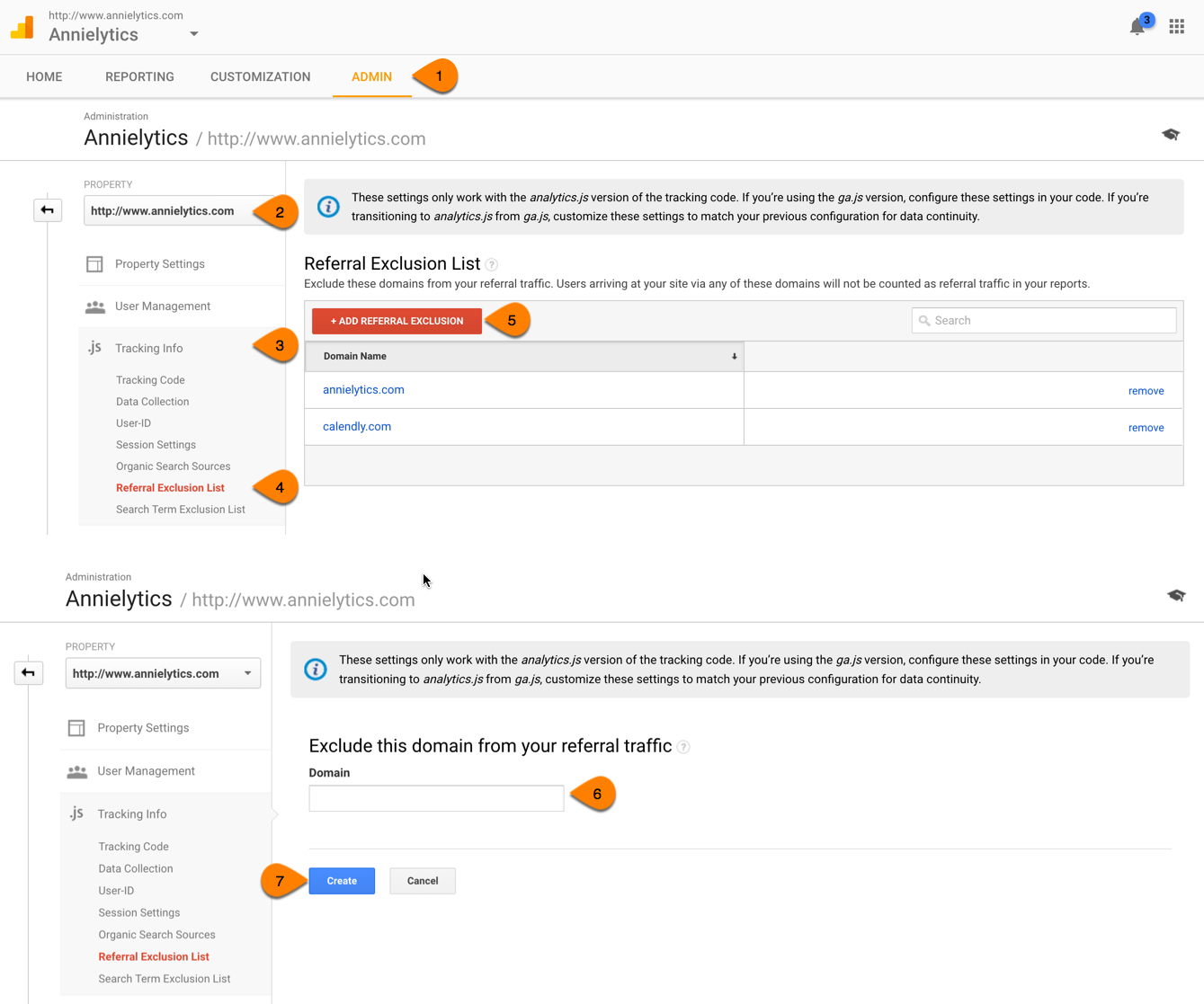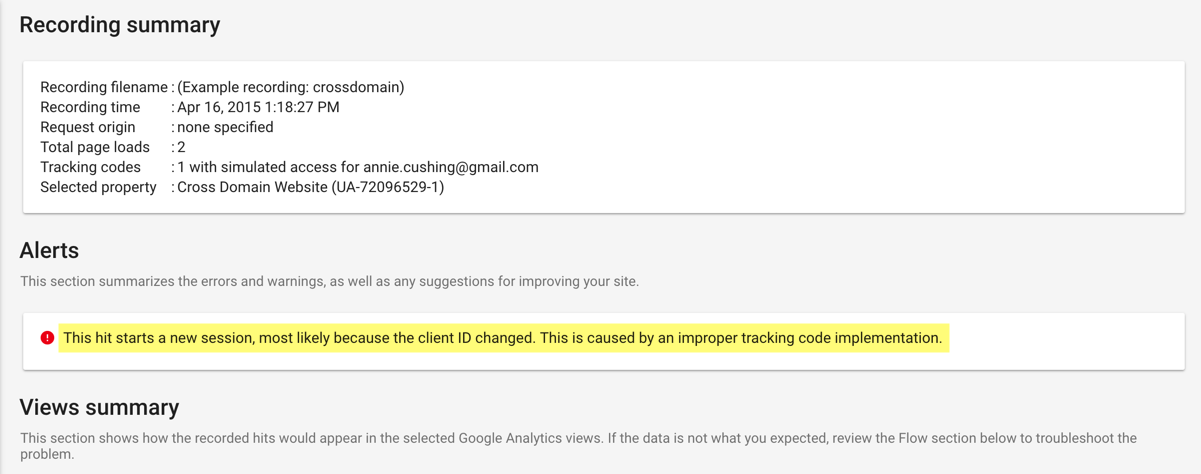A common issue I see in analytics audits is confusion over what the Referral Exclusion List is supposed to be used for. I hope to clear up some of that confusion in this post.
What Is the Referral Exclusion List?
When Google released the Universal version of Google Analytics, one of the upgrades that came with it was the Referral Exclusion List. You can find it in your property settings by navigating to Admin > Property > Tracking Info > Referral Exclusion List. Then click the + Add Referral Exclusion button, drop the domain into the Domain field (e.g., annielytics.com), and click Create.
There are two primary issues that Referral Exclusion List seeks to resolve:
Self-Referrals
Self-referrals have been a significant issue in Google Analytics since its inception. We’ve all seen them. You go to your Referrals report (Acquisition > All Traffic > Referrals) and find your own site as one of your referrals. For some sites, their own site was in their top 10 referral list before the Referral Exclusion List. And I’ve even done analytics audits and found sites where they are their own top referral.
Lost Credit for Conversions Using Third-Party Tools
When you use a third-party tool that takes a visitor off your site to accomplish some task (be it PayPal, Eventbrite, Freshdesk, etc.) or to a partner site, if the visitor returns to your site to convert or land on a thank you page, the conversion would be credited to the third-party site.
For example, let’s say you are running an event, and you use Eventbrite for event signups. When the visitor returns to your site after signing up and lands on your thank you page, which you use to track a goal conversion, the credit for the conversion would go to Eventbrite. Scandalous, I know.
How Does It Help?
Without the assistance of the Referral Exclusion List, a referral triggers a new session. When you exclude a referral source, visitors who arrive to your site from the excluded domain do not trigger a new session. If you do not want traffic arriving from a specific site to show up as a referral or to trigger a new session when returning from the third-party to your site, you will need to include that domain in your Referral Exclusion List.
So let’s say a visitor comes to your site from Facebook and moves to your third-party site, abc.com. When s/he returns, without the Referral Exclusion List, a new session would be initiated, with the referral coming from abc.com. With abc.com listed in your Referral Exclusion list, the referral would come from facebook.com.
Limitations
The Referral Exclusion List preserves the sanctity of the session. BUT it’s duct tape; it’s a plan B, if you will. If you need to know what your visitors are actually doing on your third-party domain (especially if they’re actually converting on that domain, like with PayPal**), you need to set up something called cross-domain tracking. Then you will be able to track your visitors from your domain to the partner site as if they never left your site.
Merely adding a site to your Referral Exclusion List will not allow you to see what your visitors do on the partner site. All of their activity on that site(s) will be unknown to you. Think of that site as a black box. But if you do set up cross-domain tracking, you still need to make sure the third-party/partner domain is listed in the Referral Exclusion List.
**It’s beyond ridiculous that you still can’t add a tracking pixel to your PayPal pages in 2016! If you want to use PayPal, stick to PayPal Professional. Visitors stay on your site.
Why You May Still Have Conversions Attributed to Your Site
For a while you may still see conversions attributed to your own site or a site you excluded. That’s because returning visitors who were cookied before you set up your exclusions will have their conversions attributed to the referral because in the last-click conversion model, direct doesn’t get credit for the conversion if the visitor has visited via a different campaign. (Learn more in this post about Multi-Channel Funnels.) But eventually those cookies will die off, and these conversions will attribute to the original referral.
Common Mistakes
There are some mistakes I see somewhat frequently with the Referral Exclusion List:
- Removing your domain: When you upgrade to Universal, Google automatically adds your domain to the list. But it’s a common mistake to remove your domain from the list.
- Including subdomains: You only have to list domains. You would only list a subdomain(s) if you only wanted to exclude specific subdomains on a domain.
- Listing spam sites: The Referral Exclusion List does nothing to squash spam, so don’t list spam sites. All it will do is cause that traffic to show up as direct.
- Including the wrong sites: So partner sites are tricky. If you’re using another site you control for something like checkouts or conversions and you want to preserve the original referral for conversions, then it may make sense to include it in your Referral Exclusion List. But that doesn’t mean to throw every site you own onto that list. It will result in traffic from those sites showing up as direct. It would be much better to set up a custom channel that you call Partner and include your partner sites in it. You can learn how to do that in my Channels Guide. I once had a analytics audit client get a post published on Huffington Post. In their excitement, someone excluded huffingtonpost.com. I explained to them that because of that, all of that delicious traffic showed up as direct. Again, I recommended that they create a custom channel for their syndicated content rather than use the Referral Exclusion List.
How to Test
One way to validate that the Referral Exclusion List is working properly is to use Google’s Tag Assistant (learn more). When you traverse domains, it can tell you whether an additional session was created. Look for a flag that looks like this:



My company website has ecommerce (www.thewodlife.com.au) and blog (blog.thewodlife.com.au) subdomains that are tracked using two different GA account numbers. Additionally, our website is listed in the referral exclusion list. If someone clicks into the ecommerce site from the blog and then converts, what channel ultimately gets credit for that conversion? Is that traffic (and subsequent conversion) completely excluded from the GA data or does it get credited to Direct traffic? What would be the best way to track any conversions from those that come from the blog?
If you have your subdomains in separate properties you need to use just the subdomain in the REL. Otherwise, referrals from your other subdomain(s) will show up as direct. I would also create a custom channel for your own traffic, so it doesn’t get lost in your Referrals report.
Annie, I have a site that we send users to for registration. It’s a sub-domain, but it refers back to the main site to complete a transaction/conversion. I set it up in referral exclusions and it’s still not falling out of reporting. Can you give me an idea of why this is as I didn’t see your post explain that/I might have missed the explanation. Agreed in the use of cross domain here, but was hoping this would take care of it witout having to add that piece of tracking.
thanks,
Anand
When you say it’s a subdomain, do you mean it’s a subdomain of the main site? If so, the subdomain is included when you add your domain to the REL. (And Google actually did this by default.) If it’s a subdomain of a different domain, that’s another story.
Hi,
I am confused: if I am seeing my own URL as a top referral and add it to the REL, will that traffic and all other GA metrics be suppressed or show up uin Direct? Additionally,, is putting my own URL in the REL just be “masking” the larger issue of why it is happening?
Question #2 – We recently moved from HTTP to HTTPS and still see some SEO traffic coming in on HTTP – would this show up as our own URL referring traffic?
Question #3 – If yes or no to #2 – how does, if at all, provisional headers with a “no-referrer-when-downgraded” policy affect this?
Thanks so much!!
1) This traffic isn’t suppressed. The attribution goes to the true referrer. I’m pretty critical of a lot of GA’s settings. REL isn’t one of them.
2) No. Your redirect would have to be hella slow for your site to register a redirect as a referral.
3) Not at all.
Thank you, I appreciate your input!
No problem!
I appreciate your input!
THANK YOU so much for this article. The tag assistant solved ALL my problems! I was vexed over dealing with PayPal attribution for the entire week.
Awesome, Bob! Happy to help!
Hi,
How can I exclude all domains containing the word “SEO” ? All my referrer spam have SEO in the name.
You’d want to do that with a filter, not the REL.
I have 2 websites: domain1.com and domain2.com. Rather than keeping the 2 separate websites, we have created a landing page on domain1.com (ie. domain1.com/landing-page/) and are now 301 domain forwarding domain2.com to that landing page.
We are using the domain2.com url in our Facebook advertisiing. Should we add domain2.com to our REL? Will doing so keep Facebook as the referral source, or will it simply lose all referral information and record it as direct traffic?
If domain2.com is redirecting to domain1.com, Facebook is most likely already showing up as the referral. You can use the Real Time reports (I show how here: http://bit.ly/2P5u3IR) or Google’s Tag Assistant to confirm.
Hi, Annie: This guide is awesome (as are many of your other guides). I’ve got a problem where I’m working with a site (let’s call it xyz.com) authenticates people on Facebook.com and then sends them back to the site. I don’t want to put all of Facebook on the RE, since only a small portion of the site is based on the Facebook.com login. I can control the url that Facebook sends people back to xyz.com onto. Is there some way I can leverage a URL parameter to do this? Or do you know a way I can say exclude Facebook.com referral in only just this small instance?
Hi Joe!
Thanks for the kind words! Does Facebook use a dedicated subdomain for authentication? For ex, Google uses login.google.com (I think). If so, you just list that subdomain in the REL.